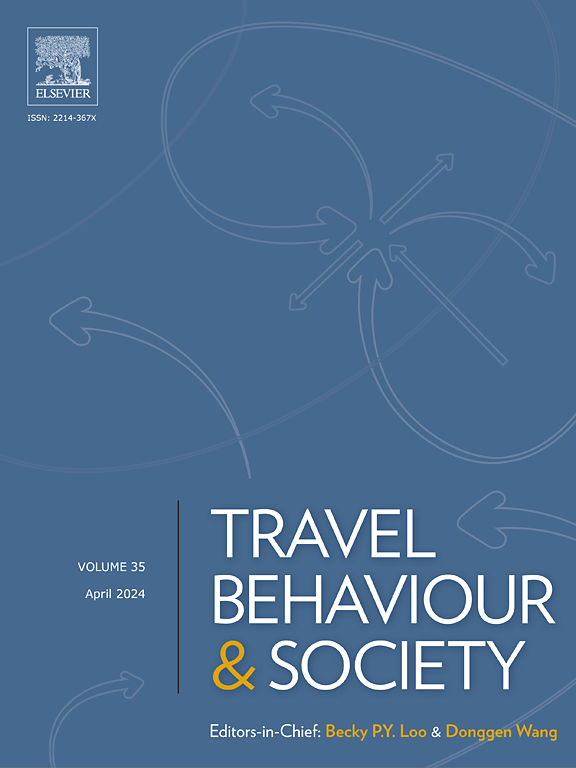了解COVID-19对出行方式选择的影响,并预测大流行后出行方式的转变
IF 5.7
2区 工程技术
Q1 TRANSPORTATION
引用次数: 0
摘要
在2019冠状病毒病大流行期间,当局采取的控制病毒的措施和对被感染的恐惧导致人员流动减少。尽管研究努力了解大流行导致的人类流动模式的变化,但由于完全依赖于在乘客层面收集的汇总数据,而不是在个人层面收集的信息,因此研究结果是不确定的。我们的研究使用了在2019冠状病毒病大流行之前、期间和之后在蒙特利尔收集的四波旅行调查数据,以评估模式选择的决定因素,并分析旅行行为和模式选择的变化。我们有来自1275名参与者的2933次与工作相关的旅行,其中只有290名参与者在第1波和第4波中都有反应,符合模式预测分析。本文采用多项多层次分析方法探讨出行行为的预测因素,并采用经典多项模型分析出行方式选择的变化。我们的研究结果显示,COVID-19期间公共交通使用量大幅下降,COVID-19之后逐渐增加,尽管无法与大流行前的水平相比。疫情发生后,公共交通使用者重返公共交通的概率是选择私家机动车的22.54倍(95%CI: 7.29, 69.66),而主动出行者的回跳率相对较高(OR: 52.71, 95%CI: 8.68, 320.20)。我们的研究表明,并非所有的可持续模式用户在2019冠状病毒病之后都恢复了使用这些模式,交通部门需要制定适当的策略来鼓励他们恢复使用这些模式,这是一个挑战。本文章由计算机程序翻译,如有差异,请以英文原文为准。
Understanding the impact of COVID-19 on travel mode choices and predicting the modal shift after the pandemic
During the COVID-19 pandemic, the measures taken by authorities to contain the virus and the fear of being infected resulted in reduced human mobility. Even though studies have made an effort to understand the changes in human mobility patterns resulted due to the pandemic, their findings are inconclusive for totally relying on aggregated data collected at ridership level rather than information at the individual-level. Our study uses four waves of travel survey data collected before, during and after the COVID-19 pandemic, in Montreal, to assess the determinants of mode choice and to analyse changes in travel behavior and mode choices. We had 2933 work-related trips from 1275 participants, of which only 290 participants responding in both wave 1 and wave 4 qualified for the mode prediction analysis. We applied a multinominal multilevel analysis to explore predictors of travel behaviour, and a classical multinominal model to analyse mode choice change. Our study’s findings show a huge decline in public transit use during COVID-19 and that it gradually increased after COVID-19, even though it was not comparable to the pre-pandemic level. The odds of public transit users shifting back to public transit after the pandemic was 22.54 (95%CI: 7.29, 69.66) times higher than choosing private motorized vehicles, while the rebound of active transport users was relatively higher (OR: 52.71, 95%CI: 8.68, 320.20). Our study implies that not all the sustainable mode users have returned to using the modes after COVID-19, and it stands as a challenge for transport authorities to develop appropriate strategies to encourage them to rebound.
求助全文
通过发布文献求助,成功后即可免费获取论文全文。
去求助
来源期刊

Travel Behaviour and Society
TRANSPORTATION-
CiteScore
9.80
自引率
7.70%
发文量
109
期刊介绍:
Travel Behaviour and Society is an interdisciplinary journal publishing high-quality original papers which report leading edge research in theories, methodologies and applications concerning transportation issues and challenges which involve the social and spatial dimensions. In particular, it provides a discussion forum for major research in travel behaviour, transportation infrastructure, transportation and environmental issues, mobility and social sustainability, transportation geographic information systems (TGIS), transportation and quality of life, transportation data collection and analysis, etc.
 求助内容:
求助内容: 应助结果提醒方式:
应助结果提醒方式:


